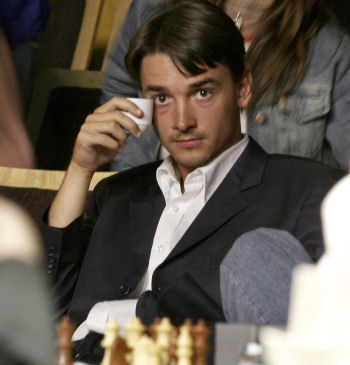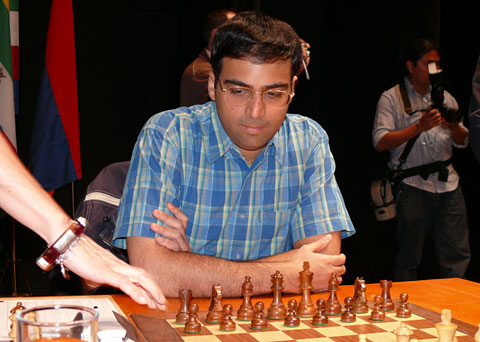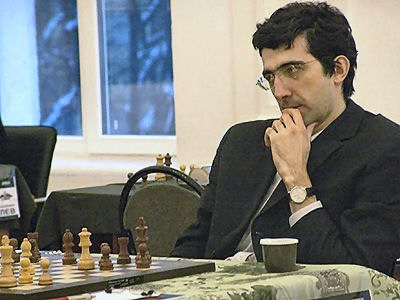| Latest | Greatest | Lobby | Journals | Search | Options | Help | Login |
|
|
|
This topic is archived. |
| Home » Discuss » Topic Forums » Sports |
|
| Jack Rabbit
|
Sat Oct-04-08 10:22 PM Original message |
| The Jack Rabbit Chess Report (October 4): The Russian Natl Champiohsip Begins in Moscow |
|
Russian National Championship Begins in Moscow
 The annual "Superfinal" of the Russian National Championship cycle began Friday in Moscow. Twelve players, led by defending champion Alexander Morozevich, will compete in a single round robin for what is probably the most prestigious of all national chess titles. The other competitors are former champions Peter Svidler and Evgeny Alekseev, Dmitry Jakovenko, Ernesto Inarkiev, Artyom Timofeev, Nakita Vitiugov, Alexander Lastin, Alexander Rianzantsev, Evgeny Tomashevsky, Konstantin Sakaev and Konstantin Maslak. After two rounds, Svidler and Lastin are on top with perfect scores, while Alekseev, Vitiugov and Rianzantsev are a half point back. Morozevich won his first round game against Sakaev but fell victim to Svidler's precise endgame play in an 87-move marathon today. The third round will be played tomorrow beginning at 3 pm Moscow tiem (4 am PDT). The games will be broadcast on the official website of the Russian Chess Federation (look for the familiar word ONLINE in Roman characters amid all the Cyrilic). Three tied in Commonwealth Championship  Defending champion Nigel Short of Britain, grandmaster Emanul Hossain of Bangladesh and Indian GM Surya Ganguly are tied for first place with 7½ points each after nine rounds of the Commonwealth Chess Championship in Nagpur, Maharashtra (India). Mr. Short is on top in spite of his setback in the third round to Indian IM Rahul Sangma, whose Elo rating at 2339 is about 300 points less than Mr. Short's. It was one of the most stunning upsets this year. Short has won seven games, more than any other player in the tournament, to compensate for the defeat. The tournament continues tomorrow with games beginning at 1 pm Nagpur time (12:30 am PDT). The 11-round event finishes Monday. Anand and Kramnik prepare for battle in Bonn  Current world champion Vishy Anand of India and his predecessor, Russian GM Vladimir Kramnik, will square off in a 12-round match for the world championship in Bonn, the Cold War capital of West Germany, beginning Tuesday, October 14. Kramnik will attempt to regain the title he loast in Mexico City last year when Anand won a championship tournament of eight of the strongest players in the world. Kramnik had held the title since the Autumn of 2000, when he defeated the great Garry Kasparov in a fourteen game match in London. Kramnik underscored his right to the title in 2006 when he narrowly defeated Bulgaria's Veselin Topalov, who held FIDE's version of the world championship after winning a strong tournament in San Luis, Argentina. That ended a long schism in chess in which two champions claimed the title simultaneously for 13 years. Anand, one of the most popular players in the world, played Kasparov for the title in 1995 in New York, losing a scheduled 20-game match in 18 games, 10½-7½; Kasparov won four games to Anand's one. Since that time, Anand remained one of the two or three top ranked granmasters in the game. He is the first world champion of Asian heritage. The winner of the match will play against the winner of a match between Topalov and US grandmaster Gata Kamsky to be held in Ukraine in December. Calendar Anand-Kramnik World Championship Match, Bonn 14 October-2 November. Twelve rounds. European Club Cup, Kallithea (Greece) 16-24 October. Asian Championships, Tehran 21-30 October. Chess Olympiad, Dresden 12-25 November. Topalov-Kamsky World Championship Semifinal Match, Lvov 26 November-15 December. Eight Rounds. FIDE Grand Prix, Doha 13-29 December. Corus Chess Tournament, Wijk aan Zee 16 January-1 February 2009. |
| Printer Friendly | Permalink | | Top |
| Jack Rabbit
|
Sat Oct-04-08 10:23 PM Response to Original message |
| 1. This week's games |
|
Your humble hare acknowledges the assistance of Fritz 6.0 on analysis. Diagrams on the Jack Rabbit Chess Report are made with Chess Mérida, a true type font that can be downlaoded free here. !""""""""# $tMvWlVmT% $OoOoOoOo% $ + + + +% $+ + + + % $ + + + +% $+ + + + % $pPpPpPpP% $RnBqKbNr% /(((((((() WHITE White to move (This position is a theoretical draw) |
| Printer Friendly | Permalink | | Top |
| Jack Rabbit
|
Sat Oct-04-08 10:30 PM Response to Reply #1 |
| 3. Pentala - Kaidanov, SPICE Cup, Texas Tech, Round 9 |
|
India's Pentala Harikrishna was awarded the SPICE Cup this year by virtue having the best tie break score among the four players who finished tied for first with 5½ points each.
He had to win his last-round game against Greg Kaidanov to win the tournament.  Pentala Harikrishna Pentala Harikrishna - Greg Kaidanov SPICE Cup, Round 9 Texas Tech University, Lubbock, 28 September 2008 Orthodox Queen's Gambit: Exchange Harrwitz Opening 1.d4 d5 2.c4 e6 3.Nc3 Be7 4.cxd5 exd5 5.Bf4
5...Nf6 6.e3 Bf5
7.Qb3
7...Nc6 8.a3
8...Na5 9.Qd1!?
9...0-0
10.Nf3 Ne4?!
11.Rc1 c6 12.Nxe4
12...dxe4 13.Nd2 b6
14.b4 Nb7 15.Ba6 Qd7 16.0-0
16...Nd8 17.Nc4
17...f6 18.Nd2
18...Ne6 19.Bg3 c5
20.dxc5
20...bxc5 21.b5!?
21...c4?!
!""""""""# $t+ + T L% $O +w+ Oo% $b+ +mO +% $+p+ +v+ % $ +o+o+ +% $P + P B % $ + N PpP% $+ Rq+rK % /(((((((() WHITE: Pentala Harikrishna Position after 21...c5c4 22.Nxc4
22...Nc5
23.Nd6!?
23...Nxa6
24.Nxf5 Qxf5 25.Qb3+ Kh8 26.bxa6 Qa5
!""""""""# $t+ + T L% $O + V Oo% $p+ + O +% $W + + + % $ + +o+ +% $Pq+ P B % $ + + PpP% $+ R +rK % /(((((((() WHITE: Pentala Harikrishna Position after 26...Qf5a5 27.Qb7!
27...Bxa3 28.Rc7 Rab8
29.Qxa7 Ra8 30.Qb7 Qxa6
31.Rxg7! Qxb7 32.Rxb7 Kg8
33.h3 Rf7 34.Rb6 Rc8
35.Bf4 f5 36.Rd1 Bf8?!
!""""""""# $ +t+ Vl+% $+ + +t+o% $ R + + +% $+ + +o+ % $ + +oB +% $+ + P +p% $ + + Pp+% $+ +r+ K % /(((((((() WHITE: Pentala Harikrishna Position after 36...Ba3f8 37.Rd5!
37...Kg7
38.Rbb5 Rc1+?
39.Kh2 Kg6 40.g4!
40...fxg4
!""""""""# $ + + V +% $+ + +t+o% $ + + +l+% $+r+r+ + % $ + +oBo+% $+ + P +p% $ + + P K% $+ T + + % /(((((((() WHITE: Pentala Harikrishna Position after 40...fg4:p 41.Rg5+!
41...Kf6
42.Rb6+ Ke7 43.Rb7+ Ke8
44.Re5+ Be7
45.Bg5 Rxf2+
46.Kg3 Rf3+
47.Kxg4 Rg1+ 48.Kh4 1-0
|
| Printer Friendly | Permalink | | Top |
| Jack Rabbit
|
Sat Oct-04-08 10:32 PM Response to Reply #1 |
| 4. Mikhalevski - Kritz, SPICE Cup, Texas Tech, Round 7 |
|
German grandmaster Leonid Kritz was another member of the foursome tied for first in Lubbock.
 Leonid Kritz Viktor Mikhalevski - Leonid Kritz SPICE Cup, Round 7 Texas Tech University, Lubbock, 26 September 2008 Slav Queen's Gambit: Chameleon Defense 1.d4 d5 2.c4 c6 3.Nf3 Nf6 4.Nc3 a6 5.c5 Bf5 6.Bf4
6...Nbd7 7.e3 g6
8.Be2
8...Nh5!?
9.Be5
9...f6 10.Bg3 Nxg3 11.hxg3 Bg7 12.Bd3
12...Bxd3 13.Qxd3 0-0
14.e4 e5 15.exd5 exd4 16.Qxd4
16...f5 17.Qb4 a5!?
18.Qc4 Qe7+ 19.Kf1 Qxc5 20.Qb3
20...Qb4 21.dxc6+?!
21...Qxb3 22.axb3 bxc6 23.Rh4
23...Nc5 24.Rc4 Nxb3 25.Ra3 Rab8!?
26.Rxc6 Rfd8 27.Ra4?
!""""""""# $ T T +l+% $+ + + Vo% $ +r+ +o+% $O + +o+ % $r+ + + +% $+mN +nP % $ P + Pp+% $+ + +k+ % /(((((((() WHITE: Viktor Mikhalevski Position after 27.Ra3a4 27...Nd2+!
28.Nxd2
28...Rxd2 29.b3 Re8
30.f3
!""""""""# $ + +t+l+% $+ + + Vo% $ +r+ +o+% $O + +o+ % $r+ + + +% $+pN +pP % $ + T +p+% $+ + +k+ % /(((((((() WHITE: Viktor Mikhalevski Position after 30.f2f3 30...Bd4!
31.Rxd4
31...Rxd4 32.Rc5 Rd3 33.g4
33...fxg4
34.fxg4 Rf8+ 35.Kg1 h6
36.Nd5
36...Rg3 37.Rxa5
37...Rxg4 38.b4 Rd4 39.Rc5
39...Rd8 40.Ne7+ Kf7 41.Nc6
41...Rd1+ 42.Kh2 R8d5 43.Rc3
43...R1d2 44.Rf3+ Kg7 45.Rg3
45...Kf6 46.Rf3+ Rf5 47.Rg3 Rg5 48.Rxg5
48...Kxg5 49.b5 Rb2 50.Nd4 Kg4 0-1
|
| Printer Friendly | Permalink | | Top |
| Jack Rabbit
|
Sat Oct-04-08 10:34 PM Response to Reply #1 |
| 5. Short - Sangma, Commonwealth Open, Nagpur, Round 3 |
|
There is no photo of Rahul Sangma available online. He is a 19-year-old international master from India who scored one of the major upsets of the year in the third round at the Commonwealth Open in Nagpur by defeating former world championship contender Nigel Short.
Nigel Short - Rahul Sangma Commonwealth Open, Round 3 Nagpur, 30 September 2008 Spanish Grand Royal Game: Kasparov Opening 1.e4 e5 2.Nf3 Nc6 3.Bb5 a6 4.Ba4 Nf6 5.0-0 Be7 6.Re1 b5 7.Bb3 d6 8.c3 0-0 9.a4
9...Bg4
10.h3
10...Bxf3
11.Qxf3 Na5 12.Bd1
12...c5!?
13.axb5
13...axb5 14.d3 Qc7
15.Qg3 Kh8 16.f4 c4
17.Kh1
17...Rfd8
18.Na3 Rab8 19.Ra2!?
19...cxd3 20.Qxd3 d5
21.Nxb5
21...Qc4 22.Qxc4 Nxc4 23.Na7
23...Nxe4 24.Nc6?
!""""""""# $ T T + L% $+ + VoOo% $ +n+ + +% $+ +oO + % $ +m+mP +% $+ P + +p% $rP + +p+% $+ BbR +k% /(((((((() WHITE: Nigel Short Position after 24.Na7c6 24...Nf2+!
25.Kh2
25...Nd3 26.Be2
26...Nxe1 27.Nxe7 e4 28.Nc6 Ra8 29.Rxa8
29...Rxa8 30.b3
30...Nd3?!
31.Bxd3!
31...exd3 32.bxc4 Ra1!
33.Bd2 Ra2 34.cxd5
!""""""""# $ + + + L% $+ + +oOo% $ +n+ + +% $+ +p+ + % $ + + P +% $+ Po+ +p% $t+ B +oK% $+ + + + % /(((((((() WHITE: Nigel Short Position after 34.cd5:p 34...Rxd2!
35.d6 Ra2 0-1
|
| Printer Friendly | Permalink | | Top |
| Jack Rabbit
|
Sat Oct-04-08 10:36 PM Response to Reply #1 |
| 6. Sakaev - Morozevich, Russian National Championship, Moscow, Round 1 |
|
Defending Russian national champion Alexander Morozevich started this year's championship with a victory over Konstantin Sakaev.
 Alexander Morozevich Konstantin Sakaev - Alexander Morozevich Russian National Championship, Round 1 Moscow, 3 October 2008 West Inida Game: Indian Queen's Gambit (Exchange Opening) (Grünfeld Defense) 1.d4 Nf6 2.c4 g6 3.Nc3 d5 4.cxd5 Nxd5 5.e4 Nxc3 6.bxc3 Bg7 7.Be3
7...c5 8.Qd2 Qa5 9.Nf3 0-0 10.Rc1 Nd7
11.d5
11...Nf6 12.Bd3!?
12...c4
13.Bb1 Ng4 14.Bd4 e5
15.dxe6 f6 16.e7 Re8 17.Qe2
17...Be6 18.Nd2 b5
19.f4 Rxe7 20.0-0
20...Qc7
21.h3
21...Nh6 22.Qf2 f5
23.Bxg7
23...Kxg7 24.Rfe1 Rae8!?
!""""""""# $ + +t+ +% $O W T Lo% $ + +v+oM% $+o+ +o+ % $ +o+pP +% $+ P + +p% $p+ N Qp+% $+bR R K % /(((((((() WHITE: Konstantin Sakaev Position after 24...Ra8e8 25.e5!
25...Bd5
26.Nf1 Rd8
27.Ne3 Qb6!?
28.Rcd1!?
28...Red7!
29.Nxd5 Rxd5 30.Qxb6?!
30...axb6 31.Rxd5 Rxd5 32.Kf2
32...Ng8 33.g4 Ne7 34.gxf5
34...gxf5 35.Rg1+ Kf7 36.Ke2 Rd8
37.Bc2?
!""""""""# $ + T + +% $+ + Ml+o% $ O + + +% $+o+ Po+ % $ +o+ P +% $+ P + +p% $p+v+k+ +% $+ + + R % /(((((((() WHITE: Konstantin Sakaev Position after 37.Bb1c2 37...Ra8!
38.Rb1
38...Nd5 39.Kd2
39...b4 40.Bxf5
40...Rxa2+ 41.Ke1
41...b3 42.Rd1 Ne3! 0-1
|
| Printer Friendly | Permalink | | Top |
| Jack Rabbit
|
Sat Oct-04-08 10:26 PM Response to Original message |
| 2. Anand-Kramnik preview |
|
This week we present one game each by the tow men who will engage in combat for the world champion in Bonn in less than two weeks.
Next week, we will examine two games Anand and Kramnik played against each other over the years. |
| Printer Friendly | Permalink | | Top |
| Jack Rabbit
|
Sat Oct-04-08 10:38 PM Response to Reply #2 |
| 7. Karjakin - Anand, Corus A, Wijk aan Zee, 2006 |
 Vishy Anand Sergey Karjakin - Vishy Anand Corus International Tournament (Group A), Round 1 Wijk aan Zee, 14 January 2006 Open Sicilain Game: Najdorf-Boleslavky Defense (Chandler-Nunn Opening) 1.e4 c5 2.Nf3 d6 3.d4 cxd4 4.Nxd4 Nf6 5.Nc3 a6 6.Be3 e5
7.Nb3
7...Be6
8.f3
8...Be7
9.Qd2 0-0 10.0-0-0 Nbd7
11.g4 b5 12.g5
12...b4 13.Ne2 Ne8 14.f4
14...a5 15.f5 a4 16.Nbd4!?
16...exd4 17.Nxd4 !""""""""# $t+ WnTl+% $+ +mBoOo% $ + Ov+ +% $+ + +pP % $oO Np+ +% $+ + V + % $pPpQ + P% $+ Kr+v+r% /(((((((() WHITE: Sergey Karjakin Position after 17.Ne2d4:p 17...b3!
18.Kb1 bxc2+ 19.Nxc2 Bb3!
20.axb3 axb3 21.Na3
21...Ne5
22.h4
22...Ra5 23.Qc3?
23...Qa8 24.Bg2
!""""""""# $w+ +mTl+% $+ + VoOo% $ + O + +% $T + MpP % $ + +p+ P% $NoQ B + % $ P + +b+% $+k+r+ +r% /(((((((() WHITE: Sergey Karjakin Position after 24.Bf1g2 24...Nc7!!
25.Qxc7 Rc8!
26.Qxe7 Nc4 27.g6
27...hxg6
28.fxg6 Nxa3+ 29.bxa3 Rxa3 !""""""""# $w+t+ +l+% $+ + QoO % $ + O +p+% $+ + + + % $ + +p+ +% $To+ B + % $ + + +b+% $+k+r+ +r% /(((((((() WHITE: Sergey Karjakin Position after 29...Ra5a3:p
30.gxf7+
30...Kh7 31.f8N+
31...Rxf8 32.Qxf8
32...Ra1+ 33.Kb2 Ra2+
34.Kc3
34...Qa5+ 35.Kd3 Qb5+ 36.Kd4 Ra4+ 37.Kc3 Qc4+ 0-1
|
| Printer Friendly | Permalink | | Top |
| Jack Rabbit
|
Sat Oct-04-08 10:39 PM Response to Reply #2 |
| 8. Kramnik - Leko, Match for the World Title, Brissago, 2004 |
|
This was the final game of the 2004 world championship match. Leko led by a point; Kramnik needed a win to tie the match and keep his title.
 Vladimir Kramnik Vladimir Kramnik - Peter Leko Match for the World Title, Round 14 Brissago, 18 October 2004 Closed German Game: Tal Opening (Caro-Kann Defense) 1.e4 c6 2.d4 d5 3.e5 Bf5 4.h4 h6 5.g4 Bd7 6.Nd2
6...c5
7.dxc5 e6
8.Nb3 Bxc5 9.Nxc5 Qa5+ 10.c3 Qxc5 11.Nf3!?
11...Ne7
12.Bd3
12...Nbc6
13.Be3 Qa5 14.Qd2
14...Ng6 15.Bd4 Nxd4
16.cxd4 Qxd2+?!
17.Kxd2 Nf4 18.Rac1
18...h5 !""""""""# $t+ +l+ T% $Oo+v+oO % $ + +o+ +% $+ +oP +o% $ + P MpP% $+ +b+n+ % $pP K P +% $+ R + +r% /(((((((() WHITE: Vladimir Kramnik Position after 18...h6h5 19.Rhg1!
19...Bc6 20.gxh5 Nxh5 21.b4
21...a6 22.a4 Kd8
23.Ng5 Be8 24.b5
24...Nf4 25.b6 Nxd3
26.Kxd3 Rc8
27.Rxc8+ Kxc8 28.Rc1+ Bc6
29.Nxf7 Rxh4 30.Nd6+ Kd8
31.Rg1 Rh3+ 32.Ke2 Ra3
33.Rxg7 Rxa4 34.f4?!
34...Ra2+?
!""""""""# $ + L + +% $+o+ + R % $oPvMo+ +% $+ +oP + % $ + P P +% $+ + + + % $t+ +k+ +% $+ + + + % /(((((((() WHITE: Vladimir Kramnik Position after 34...Ra4a2+ 35.Kf3!
35...Ra3+ 36.Kg4 Rd3 37.f5 Rxd4+ 38.Kg5 exf5
39.Kf6 Rg4 40.Rc7 Rh4 41.Nf7+ 1-0
|
| Printer Friendly | Permalink | | Top |
| DU
AdBot (1000+ posts) |
Sat May 04th 2024, 10:16 PM Response to Original message |
| Advertisements [?] |
| Top |
| Home » Discuss » Topic Forums » Sports |
|
Powered by DCForum+ Version 1.1 Copyright 1997-2002 DCScripts.com
Software has been extensively modified by the DU administrators
Important Notices: By participating on this discussion board, visitors agree to abide by the rules outlined on our Rules page. Messages posted on the Democratic Underground Discussion Forums are the opinions of the individuals who post them, and do not necessarily represent the opinions of Democratic Underground, LLC.
Home | Discussion Forums | Journals | Store | Donate
About DU | Contact Us | Privacy Policy
Got a message for Democratic Underground? Click here to send us a message.
© 2001 - 2011 Democratic Underground, LLC